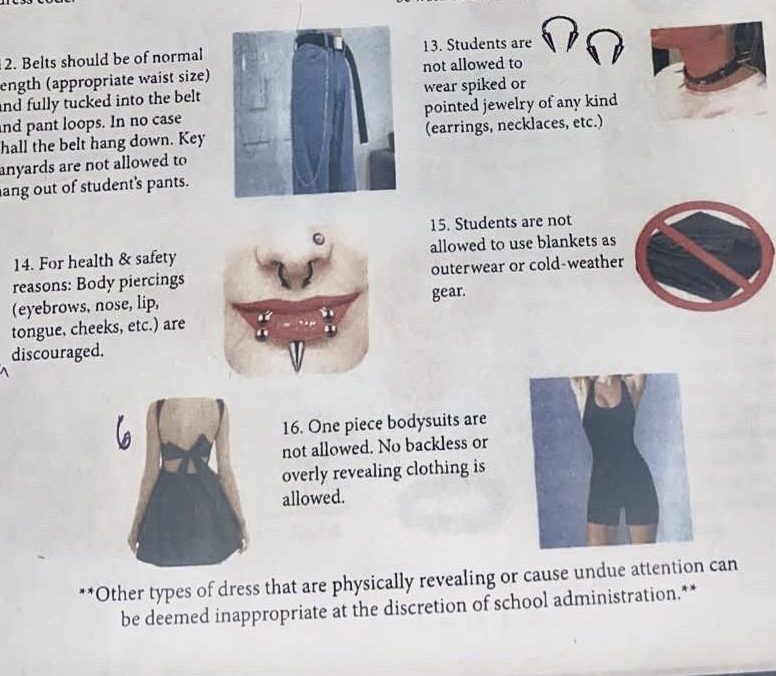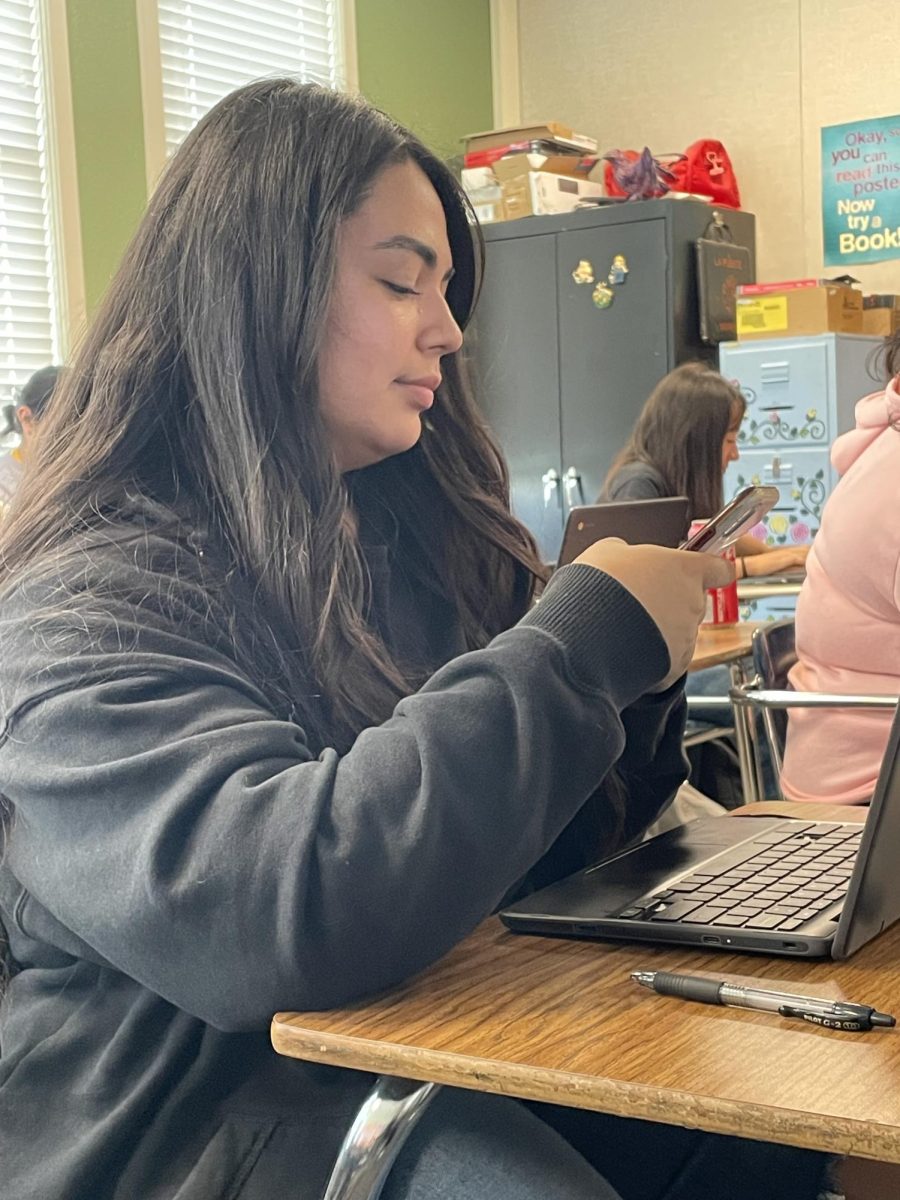As students, we’re no strangers to the constant presence of cell phones in our lives. But when it comes to school, should we be allowed to use them freely? Our school’s cell phone policy has been a hot topic of debate for a while now. This year, DHS has banned the use of cell phones during the school day, tightening the rules and the consequences for students. As a student, I can see both sides of this issue.
Cell phones can be distracting and teachers want us to focus on our work. But let’s be honest, we are not going to suddenly become more attentive just because our phones are locked away. In fact, having to place our phones into cell phone jail where cell cellphones are placed until class ends, can be a little frustrating. There might be an emergency or important messages that need to be responded to right away. For instance, a friend of mine once had an emergency where a family member was rushed to surgery, and had no idea until they got notified of missed phone calls and messages by the end of class.
I see the benefits of having a cell phone policy. It’s true that phones can be a distraction, and some students might take advantage of the freedom to text or scroll through social media during class. However, what about students like me who use phones for good? I like to take notes on my phone which is easier to write on paper. Or I can quickly look up a definition or concept I don’t understand. Sometimes our cell phone internet works better than the internet on our chrome books.
So, what’s the solution? I believe our school should find a middle ground. Maybe on Fridays we can have access to our phones when we are caught up on work, which can be times where we are allowed to use our cell phones freely. That way, students who want to focus can do so without distractions, while students like me can still use our phones for a legitimate reason.
In conclusion, while I understand the reasoning behind our school´s cell phone policy, I believe it’s time to rethink it. Let’s find a way to make it work for everyone, not just a select few. After all, we´re the digital generation. It’s time our school policy reflected that.




























Mrs. Silva • Sep 20, 2024 at 4:33 pm
Good job, Ayleen!
andrew reyes • Sep 20, 2024 at 1:33 pm
I want to be able to use my phone so here an essay about why.
The Case for Using Phones in School In today’s digital age, smartphones have become an integral part of our daily lives. Their presence extends beyond mere communication; they serve as powerful tools for learning and engagement. The debate over whether students should be allowed to use phones in school is ongoing, yet there are compelling arguments in favor of their use in educational settings. This essay explores the various benefits of allowing phones in school, highlighting their potential to enhance learning, facilitate communication, and prepare students for a technology-driven future. Enhancing Learning Opportunities One of the primary arguments for using phones in school is their ability to enhance learning opportunities. Smartphones can serve as portable learning devices, providing students with access to a wealth of information at their fingertips. With the internet, students can quickly look up facts, conduct research, and access educational resources. This immediate availability of information encourages independent learning and critical thinking, as students can delve deeper into subjects of interest and clarify their doubts on the spot. Interactive Learning Tools Many educational apps and platforms are specifically designed to complement classroom instruction. These tools can turn traditional lessons into interactive experiences, making learning more engaging for students. For instance, platforms like Kahoot and Quizlet allow for real-time quizzes and flashcards, fostering a more dynamic classroom environment. By incorporating these technologies into lessons, teachers can cater to different learning styles and keep students actively involved in their education. Collaboration and Communication Smartphones facilitate communication and collaboration among students and teachers. With messaging apps and collaboration platforms like Google Classroom, students can easily discuss assignments, share resources, and work on group projects outside of school hours. This not only helps in building teamwork skills but also encourages a sense of community and support among peers. Moreover, teachers can communicate important announcements and updates efficiently, ensuring that students remain informed. Digital Literacy and Responsibility Allowing phones in school also provides an opportunity to teach students about digital literacy and responsible usage. As technology becomes increasingly integrated into our lives, understanding how to navigate it effectively is crucial. Schools can implement guidelines that promote responsible phone usage, teaching students about internet safety, digital citizenship, and the importance of maintaining a healthy balance between online and offline interactions. This proactive approach prepares students for the challenges they will face in a digital world. Personalized Learning Experiences Every student has a unique learning pace and style. Smartphones enable personalized learning experiences by allowing students to access resources tailored to their needs. For instance, students who struggle with certain subjects can find supplementary materials or instructional videos to help them grasp challenging concepts. This individualized approach empowers students to take charge of their own learning and encourages a growth mindset. Real-World Skill Development Incorporating smartphones into the educational process helps students develop essential real-world skills. As they engage with technology, they learn to navigate various applications, manage their time effectively, and even develop problem-solving skills when faced with technical issues. These skills are invaluable in the workforce, where proficiency in technology is often a prerequisite. By allowing phone use in school, educators can better prepare students for the demands of modern careers. Bridging the Gap in Education Smartphones can also serve as a bridge for educational equity. In many cases, students from disadvantaged backgrounds may lack access to computers or high-speed internet at home. Allowing phone use in school ensures that all students have access to the same educational resources, helping to level the playing field. By providing opportunities for all students to engage with technology, schools can foster inclusivity and support diverse learning needs. Safety and Emergency Communication Another important consideration is the role of smartphones in ensuring student safety. In emergencies, having access to a phone can be crucial for communication. Students can quickly contact parents or authorities if they feel unsafe or if an emergency arises. Furthermore, schools can use apps to send alerts and updates during critical situations, ensuring that students remain informed and safe. Addressing Misconceptions Critics often argue that allowing phones in school leads to distractions and decreased focus. However, this misconception overlooks the potential for responsible phone use. By establishing clear policies and guidelines, schools can mitigate distractions while promoting positive usage. Educators can work with students to create a culture of accountability, where phones are viewed as tools for learning rather than mere distractions. Conclusion In conclusion, the benefits of allowing phones in school far outweigh the concerns surrounding their use. By embracing technology, educators can enhance learning, promote collaboration, and prepare students for a rapidly evolving world. With proper guidelines and a focus on responsible usage, smartphones can transform the educational landscape, making learning more accessible, engaging, and relevant for today’s students. As we move forward, it is essential to recognize the value of integrating technology into our educational systems and to equip students with the skills they need to thrive in a digital society.